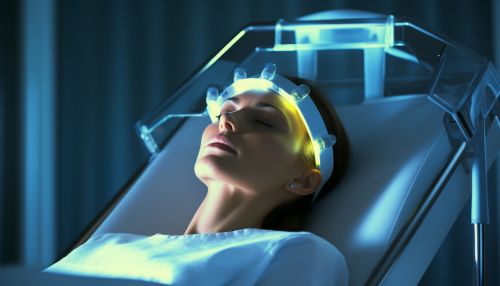Phototherapy
Overview
Phototherapy, also known as light therapy, is a treatment method that involves exposure to specific wavelengths of light using polychromatic polarised light, lasers, light-emitting diodes, fluorescent lamps, dichroic lamps, or very bright, full-spectrum light, typically with a 10,000 lux light box. The therapy is administered for a prescribed amount of time and, in some cases, at a specific time of day.


History
The concept of using light as a therapeutic intervention has its roots in ancient civilizations. The Egyptians, for instance, recognized the healing power of light and used sunbathing as a form of treatment. In the late 19th and early 20th centuries, Niels Finsen, a Danish physician, developed the first artificial light source for treatment of skin tuberculosis, a feat that earned him the Nobel Prize in Medicine in 1903.
Mechanism of Action
Phototherapy works by penetrating the skin and affecting the body at the cellular level. The light photons are absorbed by the skin and underlying tissues, where they stimulate various biological processes. For instance, in the case of ultraviolet (UV) light, it can induce the production of melanin, a pigment that helps protect the skin from sun damage, and vitamin D, which is essential for bone health.
Types of Phototherapy
There are several types of phototherapy, each utilizing different wavelengths of light and used for different conditions.
Ultraviolet B (UVB) Phototherapy
UVB phototherapy uses the UVB light spectrum and is primarily used to treat skin conditions such as psoriasis, eczema, and vitiligo. The treatment can be administered to the whole body or to specific areas.
Psoralen plus Ultraviolet A (PUVA) Phototherapy
PUVA therapy involves taking a drug called psoralen, which makes the skin more sensitive to light, followed by exposure to UVA light. This form of therapy is used to treat severe skin conditions such as psoriasis, eczema, and vitiligo.
Blue Light Therapy
Blue light therapy is used to treat acne, sun damage, and skin cancer. It works by killing certain bacteria on the skin that contribute to acne.
Red Light Therapy
Red light therapy uses low-level red light wavelengths and is used for wound healing, hair growth, and anti-aging skin treatments.
Applications
Phototherapy is used in the treatment of various medical conditions, primarily skin disorders.
Skin Conditions
Phototherapy is a common treatment for many skin conditions, including psoriasis, eczema, and vitiligo. It can help to reduce inflammation, itching, and the formation of scales.
Neonatal Jaundice
Phototherapy is the primary treatment for neonatal jaundice. The blue light used in the treatment converts the bilirubin in the skin into a form that can be easily eliminated by the infant's body.
Seasonal Affective Disorder (SAD)
Phototherapy, particularly bright light therapy, is a first-line treatment for Seasonal Affective Disorder (SAD). The light used in the therapy mimics natural outdoor light and appears to cause a change in brain chemicals linked to mood.
Side Effects and Risks
While phototherapy is generally safe, it can have side effects, which can vary depending on the type of phototherapy used. Common side effects include skin redness, itching, and dryness. More serious side effects can include burns, skin aging, and increased risk of skin cancer with long-term use.
Future Directions
Research into phototherapy continues to expand, with studies exploring its potential applications in other areas of medicine, such as mental health, neurology, and oncology.
